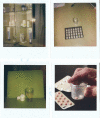'You need to be healthy to be sick': exploring older people's experiences with medication packaging at home
- PMID: 35258519
- PMCID: PMC8903009
- DOI: 10.1093/ageing/afac050
'You need to be healthy to be sick': exploring older people's experiences with medication packaging at home
Abstract
Background: the ageing global population is living longer with complex health conditions addressed by multiple medications. Little is known about how older people manage these medications and associated packaging at home.
Objectives: to explore how older people manage the use of multiple medication and associated packaging in their process of self-care.
Methods: fifteen older, home-dwelling participants (mean age = 76.2 years) participated in this study. All participants used three or more daily medications and resided in Southern Sweden. Data were collected using photographs and written diaries completed by each participant over seven consecutive days, complemented by researcher-led interviews. Interviews and diary data were analysed using thematic analysis.
Results: six major themes emerged and are discussed: systematic organisation of medication, design of medication packaging, design of tablets, ease of package opening, emotional response to the need for medication, and environmental waste.
Conclusion: packaging plays an important role in protecting products and enabling easy storage, product longevity and transportation. Medication packaging is no exception. However, the design of medication packaging poses challenges for older people managing medications for their chronic health conditions at home. There is a need to facilitate the systematic management of multiple medications, especially for new medication regimes or changes in treatment. Design of both packaging and medication should be consistent for older users to avoid potential errors; difficulties opening packaging can potentially hinder adherence to treatment. This study highlights the need for patient-centred solutions and involvement of older people in a co-design process for medication and packaging design.
Keywords: Medication adherence; medication packaging; older people; packaging design; qualitative research; solicited diaries.
© The Author(s) 2022. Published by Oxford University Press on behalf of the British Geriatrics Society. All rights reserved. For permissions, please email: journals.permissions@oup.com.
Figures




References
-
- United Nations (Department of Economic and Social Affairs Population Division) . World Population Ageing 2019: Highlights. New York: United Nations, 2019.
-
- World Health Organization . Ageing and health: Key facts 2018. https://www.who.int/news-room/fact-sheets/detail/ageing-and-health.
-
- Denton FT, Spencer BG. Chronic health conditions: changing prevalence in an aging population and some implications for the delivery of health care services. Can J Aging 2010; 29: 11–21. - PubMed
-
- Jyrkka J, Enlund H, Korhonen MJ, Sulkava R, Hartikainen S. Patterns of drug use and factors associated with polypharmacy and excessive polypharmacy in elderly persons. Drugs Ageing 2009; 26: 493–503. - PubMed

